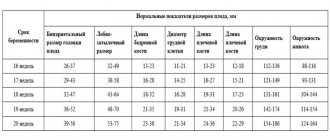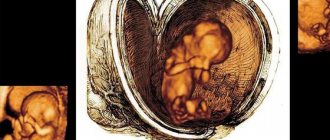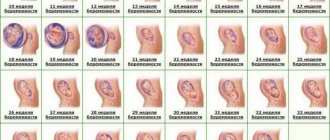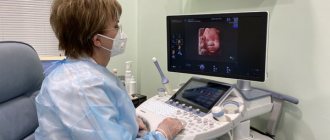Our clinics in St. Petersburg
Structural subdivision of Polikarpov Alley Polikarpov 6k2 Primorsky district
- Pionerskaya
- Specific
- Commandant's
Structural subdivision of Zhukov Marshal Zhukov Ave. 28k2 Kirovsky district
- Avtovo
- Avenue of Veterans
- Leninsky Prospekt
Structural subdivision Devyatkino Okhtinskaya alley 18 Vsevolozhsk district
- Devyatkino
- Civil Prospect
- Academic
For detailed information and to make an appointment, you can call +7 (812) 640-55-25
Make an appointment
Screening by trimester of pregnancy:
- Ultrasound during pregnancy in the 1st trimester is prescribed at 10-14 weeks. It is at this time that a specialist may notice some deviations in the development of the fetus. The first ultrasound involves measuring body length, as well as the thickness of the collar space. These indicators allow you to assess the degree of development and identify the presence of chromosomal abnormalities. Since by the end of the first trimester the most important internal organs have already been formed in the fetus, when the first ultrasound is performed, their pathology can be identified and the pregnancy can be terminated for medical reasons. Also, an ultrasound in the 1st trimester can determine the sex of the child, but more accurate data can be obtained during the second study.
- Ultrasound during pregnancy in the 2nd trimester is performed at 20-24 weeks. At this stage, the doctor can measure the abdominal circumference, thigh length, size of the fetal head, and also accurately determine its gender. A second ultrasound will help evaluate blood flow, the condition of the placenta and other functions if necessary. Ultrasound in the 2nd trimester can reveal diseases such as Rh conflict between mother and fetus, infection, impaired functioning of the fetal kidneys, umbilical cord entanglement and other problems.
- Ultrasound during pregnancy in the 3rd trimester is performed at 32-34 weeks. At this stage, the baby takes the final position, which is called presentation. It can be pelvic, cephalic, transverse or oblique. This important feature will help the doctor develop optimal delivery tactics. Also, an ultrasound of the fetus will determine the approximate date of birth, the degree of maturity of the mother’s placenta and its position.
If necessary, fetal screening can be prescribed in the early stages. For example, an ultrasound in the first month will help reliably confirm the fact of conception and establish the exact duration of pregnancy.
13,14,15,16 weeks of pregnancy: what happens, development of pregnancy and fetus
- home
- Services and prices
- Services and prices
- About Us
- Doctors
- Schedule and appointments
- Reviews
- Doctor training
- Clinic addresses
- Blog
- CIropedia
Week by week 13 - 16th weeks of pregnancy Elena Gevorkova Obstetrician-gynecologist, Moscow
Week 13
BABY
The length of the fetus is 6-7 cm at the beginning of the week, reaching 10 cm by the end. The fetus weighs about 20-30 g at this stage.
The countdown to the second trimester of pregnancy begins at the 13th week. From this period, intensive growth of the fetus occurs due to the lengthening of the arms and legs. The proportions of the body change, and the head is no longer as large in relation to the body as before. The formation of fingers and toes continues. The baby is already reaching his finger to his mouth, and often on an ultrasound you can see that the baby’s thumb is in the mouth. This is how a very important reflex manifests itself - sucking, which the child will need after birth.
Intensive growth of muscle tissue begins, especially in the area of the fetal limbs. The activity of the fetus increases significantly, it makes smoother movements, but the woman still feels them, since the fetus is in the uterine cavity in a free position and practically does not come into contact with its walls.
A remarkable fact is the completion of the formation of all 20 baby teeth. They are located under the dense mucous membrane of the upper and lower jaws of the fetus.
The gastrointestinal tract develops intensively, the intestines fit into loops, completely filling the abdominal cavity. The inner surface of the intestine (mucosa) forms special villi that line the entire area of the intestine. After the baby is born, these villi will play a very important role in digestion, absorbing nutrients from the intestinal cavity. The intestines perform wave-like (peristaltic) movements, as a result of which amniotic fluid swallowed by the fetus passes through it. They do not contain any nutrients, and their transport through the intestines is only a stimulus for the formation of the muscular wall of the intestines, preparing for postpartum life.
Future mom
The beginning of the 13th week is marked by the fact that pregnant women feel much better and finally have the opportunity to feel the full range of positive emotions associated with the period of bearing a baby. Toxicosis, malaise, and drowsiness recede. The emotional background changes, the woman becomes calmer and less irritable. This is due to more stable hormonal levels and the fact that the critical stages of pregnancy are experienced safely.
At this stage, the shape of the abdomen begins to change for most expectant mothers. As a rule, the changes are invisible to others, but pregnant women clearly notice the appearance of a rounded tummy and discomfort when wearing previously familiar things. This requires updating your wardrobe and choosing more comfortable clothes.
Week 14
BABY
The fruit is up to 13 cm long and weighs 40-45 g.
The appearance of the fetus changes due to the distinct formation of the face. The cheeks are rounded, the eyebrows are defined, and the bridge of the nose becomes more pronounced. The baby makes distinct movements - holding on to the umbilical cord, feeling his face and tummy. The head and body are covered with embryonic down, which fits tightly to the skin of the fetus. It performs a protective function by retaining a special lubricant located on the entire surface of the skin, which during childbirth will allow the baby to smoothly slide along the mother’s birth canal. Later, the thin, almost transparent germinal fluff will be replaced by thicker hairs.
During this period, important events occur regarding the fetal respiratory system. The intensive development of the muscular system concerns not only the motor muscles of the arms and legs, but also the muscles of the respiratory system. The fetus makes rhythmic and intense movements that imitate breathing. Such “training” is very important, since immediately after birth the child must take his first breath, which requires muscle effort and the ability of the muscles to obey signals that come from the brain. The glottis is partially closed, which allows a small amount of amniotic fluid to enter the lungs during “inhalation,” but with subsequent intense “exhalation,” it is pushed back out. This flushing promotes optimal maturation of lung tissue.
Noticeable changes are observed in the structure of the fetal genital organs. In girls, the ovaries move from the abdominal cavity to the pelvic cavity. In boys, the prostate gland (prostate) is intensively formed. The structure of the external genitalia is clearly differentiated into male and female genitalia, however, with ultrasound examination at this stage it is not always possible to reliably determine the sex of the fetus.
Important events occur in the organs of the endocrine system. The intensive functioning of the pancreas begins, the production of insulin occurs - the hormone responsible for the metabolism of glucose in the body. From the 14th week, the pituitary gland begins to function - the “boss” of all other glands, which controls their interaction and is responsible for growth processes. The pituitary gland is tiny in size and is located in the most protected part of the body - in the thickness of the brain, surrounded by the bones of the skull.
Future mom
The intensive growth of the uterus continues, and from this time it becomes possible to independently palpate the fundus of the uterus - its uppermost part - through the anterior abdominal wall; its upper edge is 10-15 cm above the pubis. From this period, the use of special skin care products for pregnant women is recommended. The skin of the abdomen is not yet stretched, but certain changes are already occurring in it, and it is important to use cosmetics - creams, lotions, oils that moisturize the skin.
Skin stretch marks during pregnancy (striae) appear due to ruptures of connective tissue fibers (microcracks). Changes in hormonal levels in expectant mothers reduce the elasticity and firmness of the skin, and even a slight weight gain, as well as redistribution of the subcutaneous layer of fat and swelling lead to natural stretching of the skin causing damage and the appearance of stretch marks.
The use of special cosmetics increases tissue elasticity and fills cells with moisture; in this case, when the skin is stretched, microtraumas will occur less frequently.
Week 15
BABY
By the end of the 15th week, the length of the fetus is 14-15 cm, and the weight is about 50-70 g. The growth of the limbs continues, outstripping the size of the head due to the intensive development of the bones of the arms and legs. Fetal movements are very active; he manages to repeatedly change his position in the uterus in a few minutes. Fingers and toes are fully formed. The fetus often bends its arms at the elbows and wrists, and actively clenches its fingers into a fist. The skin of the fingertips acquires a unique striation - a unique skin pattern. Nail formation begins.
At this stage of pregnancy, the fetal cardiovascular system improves. The fetal heartbeat is twice as fast as the mother's pulse (its norm is 140-160 beats per minute). The tiny heart works very intensively, pumping up to 20 liters of blood per day. The circulatory system of the fetus is improved: arteries and veins actively grow, connecting into complexes. At this stage, every organ - heart, brain, lungs, intestines, etc. - acquires its own vascular systems (arteries and veins). A dense network of blood vessels shines through the thin skin of the fetus, which is why the fruit is not the usual pink color, but red.
The formation of the nervous system goes through very important stages. The brain increases in mass, its convolutions and grooves deepen. Bones, muscles and all internal organs are intertwined with nerve fibers. A stable connection is formed between the brain (central nervous system) and the periphery. Impulses pass not only from the brain to the organs, but also in the opposite direction - this is how a very important “feedback” system is born.
By the 15th week, the source of blood cell production changes. If up to this point erythrocytes (red blood cells) were produced by the liver and yolk sac, then from the 15th week this function is taken over by the red bone marrow, which is located inside the bones.
From this period it becomes possible to determine the blood type and Rh factor of the fetus. Of course, the group and Rh are predetermined at the moment of conception, when the fusion of the parents’ chromosomes occurs, but the implementation of this information (the formation of special antigen proteins on the surface of red blood cells) occurs at this stage.
Future mom
The pregnant woman's belly continues to increase in size, at this stage its growth occurs quite smoothly. The uterus has a round shape, its bottom can be felt 15-20 cm above the pubis.
Skin pigmentation may appear both on the abdomen and on any other part of the body - arms, legs, face, chest, back of the expectant mother. As a rule, on the stomach this manifests itself as a brown line stretching from the pubis to the navel, or separately located spots of irregular shape. Skin pigmentation is associated with intensive production of melanin pigment and its deposition in the skin due to changes in hormonal levels, and occasionally due to a lack of vitamins. The appearance of age spots should not be accompanied by feelings of discomfort, redness, or swelling of the skin. If something like this happens, you should tell your doctor, as this could be a sign of an allergic reaction or a skin disease (dermatosis of pregnancy). The color of the line or spots can vary from light beige to dark brown. As a rule, these phenomena disappear on their own after childbirth. You should not use whitening creams without consulting your doctor: it may be unsafe for your baby.
Week 16
BABY
The fetus develops facial muscles, and he begins to train them - he frowns, opens and closes his mouth. The baby opens his eyes for the first time, which were previously tightly closed, and learns to blink. Eyebrows and eyelashes are represented by thin vellus hairs. The ears are already in their usual place, whereas before this period they were located quite low - at neck level. At this stage, the inner ear is not yet able to hear, but the fetus’ reaction to loud sounds is clearly visible. This is due to a special type of perception of sounds - bone conduction; the fetus seems to “hear” with the dense parts of its body - the bones.
The fetus has already formed all the bones and joints. But the bones are still very soft, and the process of strengthening (ossification) will continue not only throughout pregnancy, but also after the birth of the child until puberty.
At 16 weeks, the external genitalia are already clearly visualized, and with an ultrasound examination, the baby’s gender can be determined almost accurately.
Intensive work of the fetal kidneys is noted. From this period, the kidneys take on part of the excretory function, somewhat reducing the load on the placenta. During the day, the fetus swallows about 300-500 ml of amniotic fluid, which passes through the kidneys and is converted into urine. The fetus secretes urine every hour in small portions into the amniotic fluid through the formed urethra.
Future mom
The general well-being of pregnant women, as a rule, improves significantly. Appetite normalizes, gradual weight gain begins; by this moment it should not exceed 2.5-3 kg.
The growth of the abdomen at this stage of pregnancy is associated both with the development of the fetus and with a more intense accumulation of amniotic fluid. The belly protrudes quite noticeably, but does not restrict the pregnant woman’s movements and does not give her a feeling of discomfort. And although the size of the belly is small, nevertheless, the time comes to change some of your habits in connection with its growth. This applies to the choice of body position during sleep. It is not recommended to sleep on your stomach or back. In the first case, this may be uncomfortable for the baby and disrupt blood flow in the uterus. In the second, the uterus puts pressure on large veins, which impairs the outflow of blood, can provoke cramps, swelling of the legs and aggravate varicose veins. It is optimal to sleep on your side: this position is most comfortable for both mother and baby.
Types of ultrasound during pregnancy
Depending on the technical equipment of the clinic and certain indications, ultrasound can be performed in different ways:
3D ultrasound is a high-tech study that allows using ultrasound to obtain a detailed image of the fetus in three projections, determine the gestational age, the number of fetuses, the condition of the placenta and amniotic fluid. Also, using 3D ultrasound, it is possible to diagnose intrauterine developmental defects: defects in the formation of limbs, spine, and facial bones. Finally, a color image with a 3D effect is displayed.
4D ultrasound allows you to assess the current condition of a pregnant woman and her fetus in real time. During the procedure, future parents can quite accurately see the features of their baby, his smile, and observe his movements. Therefore, it can be argued that such a diagnostic procedure is characterized by high reliability and accuracy of the data obtained.
Another type of ultrasound during pregnancy is Doppler ultrasound during pregnancy. This study allows you to evaluate the blood flow of the fetus or placenta and identify characteristic abnormalities. The technique is carried out in the same way as a regular fetal ultrasound, but in this case the doctor uses a special sensor.
To identify malformations of the cardiovascular system, a research method such as echocardiography may be prescribed. It is used when the fetal heartbeat with various abnormalities (arrhythmia, tachycardia, etc.) is heard. Such an ultrasound of the fetus can reveal characteristic changes in the functioning of the heart and prescribe the necessary treatment.
Thoughts and emotions
The nervous systems of a pregnant woman and the baby within her constitute, in fact, a ONE WHOLE whole. Integration (interconnection) is carried out through hormones and a single circulatory system.
The thoughts and emotions experienced by a woman are accompanied by the release of various hormones into the blood, which allows the baby to feel and empathize with everything.
The baby's empathy and sympathy that arises during hair removal and dental treatment are not desirable during pregnancy.
In order not to “walk like a bear” during pregnancy, our obstetrician-gynecologists teach pregnant women to “PERSUADE” the baby at the stage of preparation for the “experience of feelings.”
| 3D photo of a fetus at 32 weeks. The fetus covers its face with its hand | |
| 3D photo of a fetus at 28 weeks. He waved his hand and stuck out his tongue |
|
| 3D photo of a fetus at 24 weeks. Hid! |
|
| Photo of the fetus. Fetal emotions |
|
See all photos
The intrauterine baby experiences the same pain and fear as the pregnant woman herself, for example, during hair removal, bruises, visiting the dentist, conflict with her husband and people around her, etc.
KEEP A JOURNAL OF EMOTIONS and WRITE DOWN all your ideas and impressions, and immediately afterwards mentally relax, forgive and “let go” of the situation.
Be GENERIOUS, uncritical and take EVERYTHING as a GIVEN.
This is very important, since now you are responsible for the health and psychological state of the child.
You can RECORD your EMOTIONS and impressions regarding the stages of pregnancy in the Journal of Emotions on our website in articles corresponding to the stage of pregnancy. Look at the Journal of Emotions 12 weeks of pregnancy...
CLEAR YOUR THOUGHTS! Remove garbage from your life: unnecessary films and conversations, social propaganda programs and television shows, empty books and unnecessary contacts, uninteresting and envious people. It is worth renewing your personal connection with Nature more often - going to a public garden, a park, going out of town, into the forest, to lakes...
In a person’s memory, like in a fireproof cabinet, the SENSATIONS of experienced fears and JOYS are firmly stored.
The intrauterine baby feels and carries through his entire life, like a deeply recorded program, the feeling that he is LOVED and CAREFUL...
Our Pregnancy Clinic is attended by an experienced obstetrician-gynecologist who specializes in proper nutrition during pregnancy.
A SPECIALIST IN PROPER NUTRITION during pregnancy will tell you how to correctly create a menu, CHOOSE a non-starving diet for you that will maintain an attractive figure and prevent you and your baby from gaining excess weight, and will help organize healthy and TASTY nutrition throughout the trimesters of pregnancy.
Obstetrician-gynecologists of the Pregnancy Clinic are ALWAYS READY for pregnant women registered in our Clinic, if it is impossible to contact them in person, to comment on an existing or newly emerging situation by phone and SUGGEST ways to solve it.
Pregnant women who are registered at our Pregnancy Clinic have the opportunity to take an OXYGEN COCKTAIL made with natural juices for FREE every day at a convenient time and at every doctor’s visit.
The obstetrician-gynecologists of the Pregnancy Clinic have accumulated extensive EXPERIENCE in successful and JOYFUL pregnancy management.
Our experience is the result of the good work of all employees of our Clinic.
Is ultrasound harmful to the fetus?
Ultrasound for the fetus has been performed for more than half a century and during this time many scientific studies have been conducted in which attempts have been made to identify the level of negative effects of ultrasound on the fetus. However, to date such data have not been obtained. That is why doctors prescribe fetal ultrasound as planned (ultrasound in the 1st, 2nd and 3rd trimester), as well as if certain diseases are suspected or in the presence of characteristic symptoms.
Ultrasound during pregnancy is a simple, informative and cheap diagnostic method that allows you to quickly assess the health of the mother and fetus. Every expectant mother should know when an ultrasound is performed and undergo the examination in a timely manner.













